by Gabriella Radujko
on March 12th, 2013
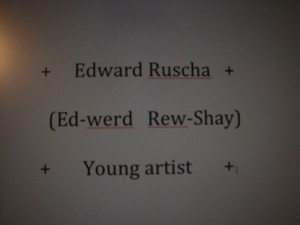
Photo: Gabriella Radujko; reproduction of content on retired Edward Ruscha business card
There is no School of Edward Ruscha, but if there were, prerequisites would include an embrace of ambiguity and the spirit world–its students paraphrasing quotes such as these from his recent talk with Paul Holdengräber at the New York Public Library on March 6, 2013:
I have a deep need to make a book.
It doesn’t matter what it is about.
The idea for a book comes first.
As book artist, Ruscha challenged his interviewer and the audience. There was puzzlement among the literati, perhaps, because as book readers, according to Walter J. Ong, we humans are so literate that it is “difficult for us to conceive of an oral universe of communication or thought except as a variant of a literate universe”. Continue Reading More »
Comments closed
by Gabriella Radujko
on January 4th, 2012
-
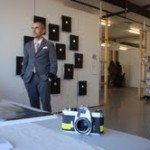
-
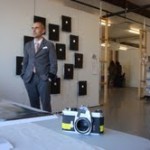
-
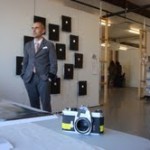
-
photo by Gabriella Radujko
Whereas Man Ray and László Moholy-Nagy famously eliminated the camera altogether to make photograms by capturing light directly, Brad Farwell retains the camera, but not the lens for his ongoing series
Die Transfer Process. The artist was one of twenty artists-in-residence showing at the Lower Manhattan Cultural Council’s Final Open Studios in Building 110 on Governors Island on December 9, 2011. The wall installation features about a dozen unique, 35mm transparencies shown with Polaroid slide mounts, atop custom light boxes staggered on a white wall covering approximately 6’ x 8’. White extension cords were in plain sight. Farwell gives viewers the physical object, but the images are not much more than the color field. Irresolvable in their lack of focus and reminiscent of the painterly effects associated with Helen Frankenthaler, the artist offers, “what is being photographed is not the subject of photography”.
Continue Reading More »
Comments closed
by Gabriella Radujko
on April 14th, 2010


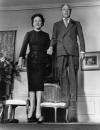
What do Richard Nixon, Marilyn Monroe, Brigette Bardot and the Duke and Duchess of Windsor have in common? The answer is jumpology, the scientific art captured by photographer Philippe Halsman, now on view at the Laurence Miller Gallery show “Jump” through May 28, 2010. It is the first time the series has been exhibited in New York.
In addition to the 101 Life magazine covers to his credit, Latvian-born Halsman boasts a 37 year collaboration with Salvador Dali which is captured in the 1949 Popcorn Nude, one of the show’s most gravity-defying images featuring popcorn, nude model, and baguette in mid-air, Dali himself propelling the explosion of popcorn by kicking a bread warmer. The innocence and spontaneity of the shot is contraindicated by Halsman’s demand of all of his subjects, namely, JUMP!
Artcards learned that Halsman hired his future wife, Yvonne Halsman, who printed many of the works shown, as an apprentice in an attempt to get rid of the competition, “by hiring them” according to one of Halsman’s daughters, Irene, who was present at the opening. Additionally, she noted that Einstein and President Roosevelt’s wife played critical roles in helping Halsman immigrate to the States.
“Capturing the essence of his subjects’ character” is what Halsman’s daughter was most intent on highlighting as the significance of her father’s work. While Halsman indicated that “the jump denotes a lack of ambition and sensuality”, it’s a characterization that is more a reflection of his singular ability to persuade the most conservative of adults to show the camera what inhibition or joy looks like.
Comments closed








 RSS
RSS
